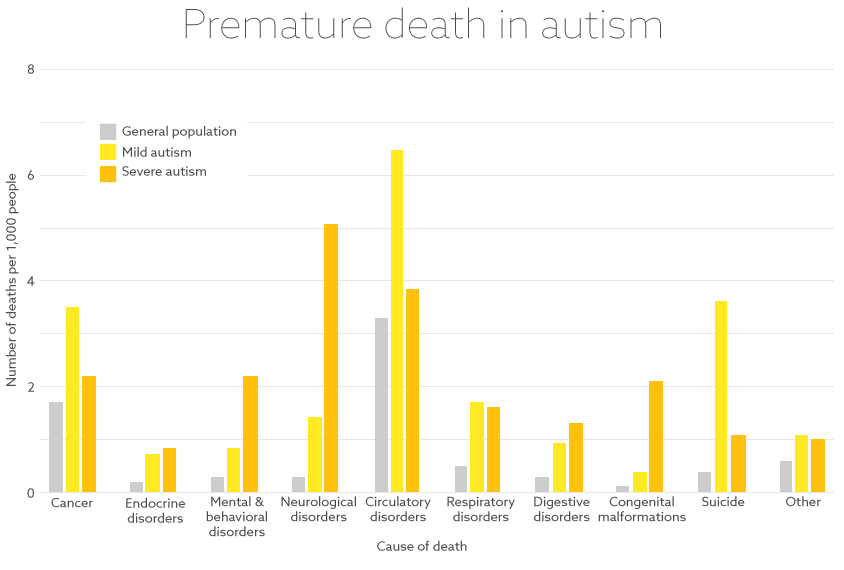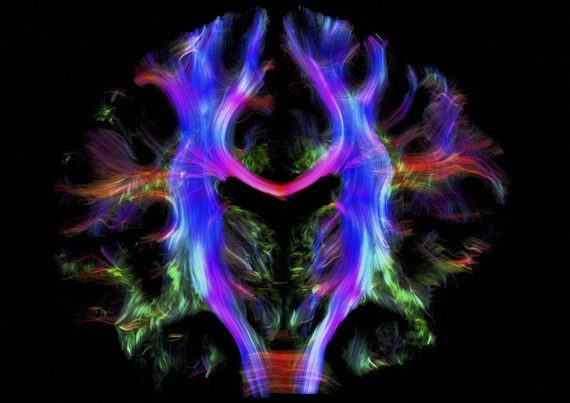WEEK OF
March 14th
A report released today highlights a disturbing statistic: People with autism die an average of 16 years earlier than those without the condition.
The report, spearheaded by British advocacy group Autistica, urges researchers, policy makers and service providers to “step up” and “start saving lives.”
Jon Spiers, Autistica’s chief executive, notes that some people with autism and learning disabilities die more than 30 years before their time. “We cannot accept a situation where many autistic people will never see their 40th birthday,” he writes in the report.
The report is largely based on a Swedish study published late last year, which found people with autism are more than twice as likely as those without the condition to die prematurely. Epilepsy is the most common cause of death among people with severe autism, whereas suicide is more common among those with milder symptoms.

Short shrift: For virtually all causes of death studied, death rates are higher in people with autism than in the general population.
Nigel Hawtin
A new book entitled “The Prodigy’s Cousin” explores the link between autism and extraordinary talent.
The book is based on research by Joanne Ruthsatz, assistant professor of psychology at Ohio State University, who has been studying child prodigies for 14 years. Ruthsatz teamed up with her daughter, Kimberly Stephens, to detail some of Ruthsatz’s incredible case studies, including a 2-year-old who spelled words such as ‘algorithm.’
Not all prodigies have autism, but many have family members on the spectrum, hinting at a genetic link between the condition and genius. We explored this possibility in the deeply reported piece “Extraordinary minds: The link between savantism and autism.”
More and more researchers are embracing the ‘preprint,’ posting early versions of their papers online before surrendering them to the months-long peer review process for prestigious journals.
An article in The New York Times this week explores this trend. Journalist Amy Harmon compares preprint publication to other industry game-changers, such as Stephen King’s 2000 e-book and Radiohead’s 2007 download-only album. Scientific journals might not like it, but many researchers agree the development is long overdue.
“It’s pretty amazing that it took 20 years for ‘scientists should post their work on the Internet’ to not be viewed as radical,” Michael Eisen, professor of genetics, genomics and development at the University of California, Berkeley, tweeted from the ASAPbio meeting last month.
BioRxiv, a preprint server for biology research, currently hosts 121 papers that mention autism — 23 of them submitted this year.
Who really owns CRISPR? Aliens, according to Anne Simon, a virologist at the University of Maryland and science advisor for the latest season of “The X-Files.”
Spoiler alert!
The six-episode reboot of the 1990s sci-fi series centers on the fictional Spartan virus, which was created by aliens and spread to all of us through the smallpox vaccine. Nature’s Sarah Reardon explains:
“The virus contains the code for CRISPR and the enzyme CAS9. It spreads through the body and snips at the gene for adenosine deaminase: an enzyme essential for immune function. When the virus is activated through ions spread in aeroplanes’ vapour trails — yes, the chemtrail conspiracy theory — the CRISPR system begins destroying immune systems. Soon, everyone, including Mulder, is dying of simple diseases.”
Scully has alien DNA, of course, which she uses to make a vaccine. Will it work? We’ll have to wait for the next season to find out.

© Alfred Anwander/MPI-CBS. Wellcome Images
An eerie image of a premature baby bathed in ultraviolet light took home the Wellcome Trust’s Julie Dorrington Award for outstanding photography in a clinical environment this week. The baby was receiving treatment for jaundice, a condition characterized by yellow skin, caused by a buildup of bilirubin in the blood.
“The whole image is cast in a beautiful blue light,” the judges wrote of the image, snapped by photographer David Bishop of the Royal Free Hospital in London, U.K.
The image was one of 20 finalists for the Wellcome Image Awards, an annual celebration of biomedical imagery. One of our favorites is a colorful portrait of brain connections lit up like neon threads. The image, submitted by Alfred Anwander, a researcher at the Max Planck Institute for Human Cognitive and Brain Sciences in Leipzig, Germany, shows thick bundles of nerves linking the left and right hemispheres and cascading like water from the brain’s outer shell to the spinal cord.
Editor’s note: The increased risk described in ‘Mortality crisis’ has been corrected to indicate that it is associated with intellectual disability, not learning disabilities. In the U.S., the term learning disability is used only to describe conditions such as dyslexia.
By joining the discussion, you agree to our privacy policy.